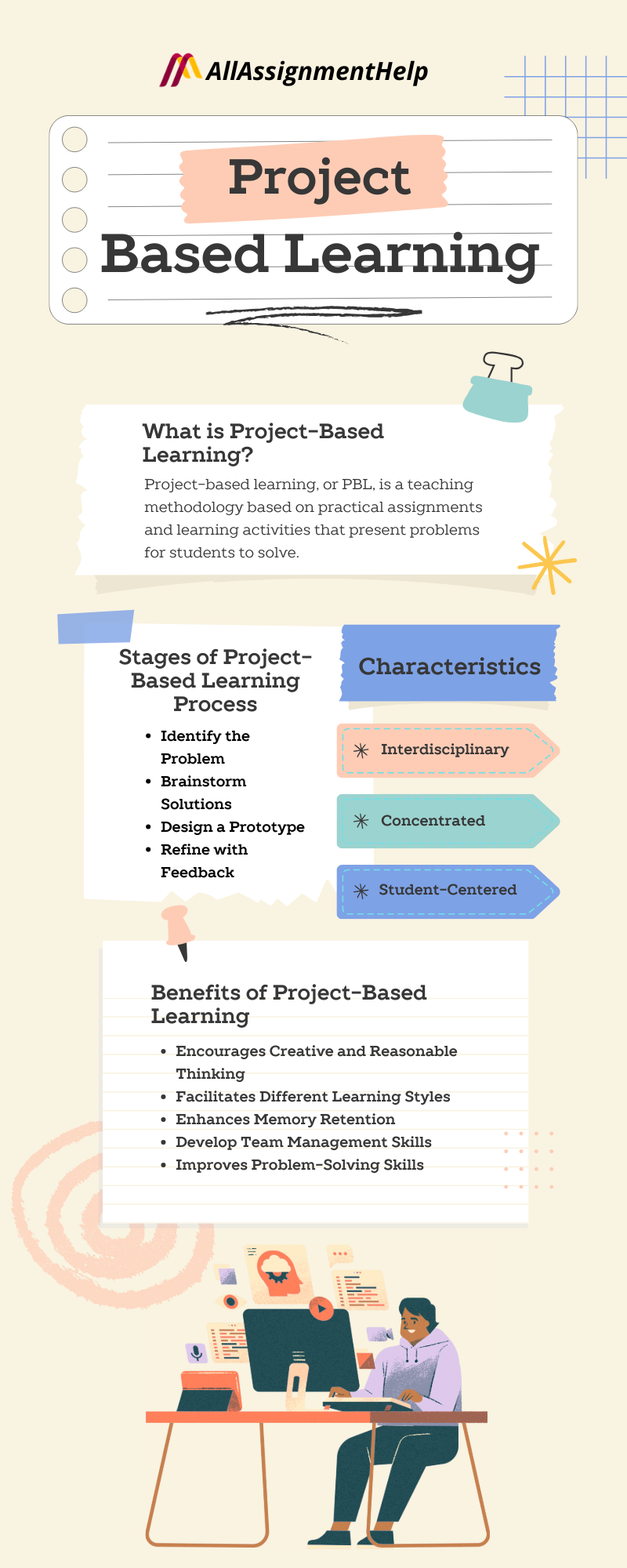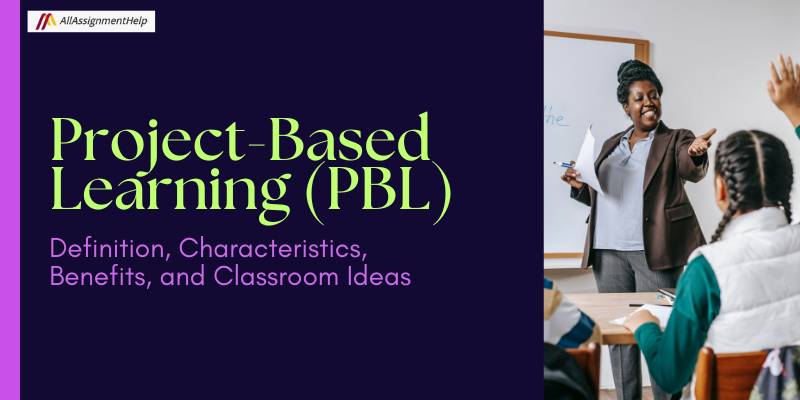Table of Contents
Project-based learning, or PBL, is a teaching approach that centres on real-world problems and difficulties using problem-solving, decision-making, and analytical skills. PBL can help students acquire self-directed learning skills. PBL offers chances for more in-depth contextual learning as well as the development of critical skills needed for college and job preparedness.
Moreover, project-based Based Learning activities allow students to consider their own thoughts and viewpoints and make choices that impact project results and the educational process as a whole. However, you must be thinking about what is Project-Based Learning as a whole. Don’t worry! This blog of All Assignment Help is just written to make you familiar with this learning concept. Read this blog and understand Project-Based Learning strategies and how they can benefit you.
What is Project-Based Learning?
Project-based learning, or PBL, is a teaching methodology based on practical assignments and learning activities that present problems for students to solve. In general, these activities mirror the types of learning and work that individuals engage in outside of the classroom. Student groups often collaborate to carry out PBL and achieve a shared objective.
In general, PBL leads students through the following stages or processes:
- Finding a problem
- Coming up with a solution to the problem
- Creating and designing a solution prototype
- Modifying the answer in accordance with input from peers, educators, and/or experts
PBL varies from subject to subject. Hence, students will have to deal with multiple types of problems. However, they always take assistance from an online assignment help service whenever they find themselves stuck while solving a problem.
Read Here: Why Collaborative Learning Matters in the 21st Century Classroom
Fundamental Characteristics of Project-Based Learning
Although project-based learning differs from classroom to classroom, it is often defined by the following characteristics:
Interdisciplinary
The goal of a project-based curriculum is to use practical problems to captivate students. Since real-world problems are rarely resolved with understanding or skills from a single academic area, this is an interdisciplinary approach. Projects need students to participate in investigation, solution creation, and product construction to handle the problem or challenge posed. Therefore, students often use their content skills and knowledge from several academic fields to effectively finish the assignment as they work on it.
Concentrated
In project-based learning, information and skills must be applied rather than only remembered or understood. In contrast to rote learning, PBL assesses students’ application of a range of academic material in unusual situations. Students start a project by posing a question to themselves. As students apply their academic knowledge in practical settings, inquiry develops critical thinking. After the problem has been understood, solutions are developed as a result of the inquiry process. As a result, they showcase their expertise in action by developing solutions that are intended to convey remedies to an audience.
Student-Centered
PBL changes the teacher’s role from material delivery to project management and facilitation. Throughout the PBL process, students become more self-sufficient, with the teacher offering assistance only when required. Students are encouraged to choose the best way to complete their tasks and show what they have learned. The PBL approach enables students to be independent, take responsibility for their work, and build workplace and 21st-century skills.
The project-based learning creates a constructive learning environment for students by enabling them to identify and solve problems in different academic subjects. This includes subjects like maths, science, social science, and so forth. Sometimes, there are instances where you might get stuck while solving the problems. This is where you can take help from assignment help services, whether you are looking for math assignment help, help with science, or social science assignments. These services always have subject experts to assist you with your learning.

Benefits of Project-Based Learning
Project-based Based Learning for students has several benefits, one of which is that it helps them relate to the real world. Besides, the other benefits include:
Encourages Creative and Reasonable Thinking
Working on projects with different levels of complexity and intensity helps you build critical thinking skills, which are crucial for career longevity in a firm. However, it won’t help you in the long run to study a program that doesn’t prioritize project-based learning, since you might not be able to apply the principles you learn in class.
Facilitates Different Learning Styles
Every student has a unique level of understanding as well as learning potential. While particular individuals pick up concepts quickly, others take their time. However, with the help of interesting assignments and interactive learning resources, students can readily grasp some subjects that become dull when taught using conventional techniques. This is one of the primary benefits of project-based learning, as it allows you to make use of many learning styles to fully explore a subject while understanding it in your own style.
Enhances Memory Retention
It is quite normal to forget anything you have read. However, when you are forced to use what you have learned and conduct further research, you are more likely to recall things. Compared to reading basic material in books, memory retention rises when you work on a topic repeatedly and synthesize the knowledge. For example, if you are working on a computer science project, you will learn how to code and troubleshoot when required. However, those who are unable to code can take computer science assignment help from experts.
Develop Team Management Skills
Working in a group is necessary for many tasks, which teaches you how to listen to people, share your ideas, and resolve problems. Collaborating on group projects can help you learn how to effectively manage your time and multitask.
Improves Problem-Solving Skills
If you are assigned a real-world situation-based project, you will be motivated to come up with the most innovative answer. Finding the solution or outcome will allow you to consider several possibilities, and you may even need to start from scratch. Moreover, the problem-solving skills acquired at this point are advantageous.
Despite its multiple benefits, it also has several drawbacks. However, project-based learning can be maximized when teachers and students work together.
Project-Based Learning Ideas for Classroom Learning
As you know, it’s not always easy to come up with a motivating question for educational experiences that are relevant to the actual world. However, we are here to assist you with that. Here are some ideas to get you started with project-based learning activities in your classroom:
The Economics of Pizza
The first step in this project-based learning assessment is to select a pizza business, look up its prices, and use linear algebra to figure out the basic cost of a pizza. With these similar concepts, students will be able to calculate the cost of each extra topping.
However, that’s not the end of the story. The cost of sourcing each topping should be explored by students, either alone or in small groups. Then, they can ascertain which pizza varieties have the highest and lowest profit margins. By doing this, you can introduce students to fundamental economic concepts and inspire them to think critically about business.
Fashion Designing and Marketing
Using a scenario that blends business with the visual and verbal arts, and ask students to assume the roles of fashion designers and marketers.
In this scenario, a customer (you) asks fashion agencies (small student groups) to look after the design and release of a certain piece of apparel, such as a dress or jacket. Despite having a very clear concept, you are unable to explain it. The authorities must first create a questionnaire to get information from you. Each agency can start the following stages as soon as you respond to them. Creating mock-ups, crafting ads, and figuring out a fair sale price are a few examples. Following the completion of this task, each agency will present you with its version of the item. You choose the person who most effectively communicated the client’s concepts.
Ancient Machines
Start this study exercise alone or in pairs to discover how science and engineering from the past continue to influence ancient machines.
Students or pairs begin the practice by selecting a basic machine, such as a pulley, lever, wedge, or other ancient tool. They have to go into the history of their instruments to find out where and how engineers and scientists still use them now. One hundred years from now, students might imagine how the same tools will be used in innovations. However, they can create presentations, movies, or simulated interviews with innovators to communicate their findings and study.
Recipes You Love
Ask your students to assess their favorite foods and dishes for presentations on specific recipes to introduce nutrition in a quantitative way.
Every student should select two sides, a dessert, and a main meal. Then, they are required to prepare and present presentations that explain how to prepare the food. But rather than following conventional cooking guidelines, the primary focus is on the nutritional qualities of the components, such as calories, carbs, daily vitamin consumption, and so forth. It might be necessary to provide students with a resource to use to get this knowledge, but it is their responsibility to prepare a nutritious meal.
Designing a New Playground
Provide students a chance to use their understanding of geometry and ask them to create a new school playground.
Give them a task: plan out the playground while following specific requirements using any number of free web programs or just grid paper and a pencil. These requirements should be predicated on the playground’s elements, such as the monkey bars and slides, having a specific quantity of 2D or 3D forms. For example, four squares, three equilateral triangles, at least two isosceles triangles, and so on. After finishing, each student has to figure out the size of his or her playground, including its perimeter and each component.
Moreover, PBL is such a flexible and adaptable teaching method that it can be used with ease in an online class as well. Still, there are many students who are not familiar with taking classes online or find it a little bit challenging. Such students can always take online class help just by asking, can you take my online class for me? With this simple query, you can hire an online class helper to take the stress off your shoulders.
Also Read: Everything You Need To Know About Game-based Learning
Conclusion
The majority of real problems are ones that need to be solved together. PBL provides students with chances to improve and expand their skills to collaborate with others on significant and challenging problems. All you have to do is study more about the methodology of project-based learning and how to plan and implement a project in the classroom. However, if you are a student and need help with academic assignments and projects, you can count on us for assistance. We have experts available in all academic areas who can even take your online exam on your behalf to help you succeed academically.
FAQs
What is the importance of project-based learning?
Project-based learning is important because it equips students with practical skills they will use throughout their lives and motivates them to view worthwhile learning possibilities with curiosity.
What are the core principles of project-based learning?
The effectiveness of project-based learning as a pedagogical paradigm depends on its fundamental principles: inquiry-based learning, real-world connection, collaboration and teamwork, student voice and choice, reflection and feedback, and authentic assessment.
What part does the teacher play in project-based learning?
Project-based learning (PBL) places a higher value on developing real-world learning opportunities. Teachers coach students as they work through problems and consider solutions rather than taking the lead. It’s about not having all the answers, but being there to help them when they need it.
